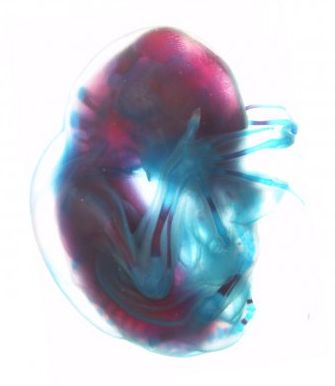- About
- Organization
- Organization Overview
- Dean’s Office
- Department of Bioengineering and Therapeutic Sciences
- Department of Clinical Pharmacy
- Department of Pharmaceutical Chemistry
- Quantitative Biosciences Institute
- Org Chart
- Research
- Education
- Patient Care
- People
- News
- Events
Ahituv Lab research finds how bats grow wings, with implications for human limb development
By David Jacobson / Mon Mar 28, 2016

Mandy K. Mason, University of Cape Town
Natal long-fingered bat embryo (Miniopterus natalensis) stained to highlight bone (red) and cartilage (blue).
Researchers in the laboratory of UCSF School of Pharmacy faculty member Nadav Ahituv, PhD, study the roles of gene regulatory elements—DNA segments that tell genes when, where, and to what extent to turn on and off—including in human conditions ranging from limb malformations to epilepsy and autism.
Now a branch of that research has led to fundamental discoveries about how bats develop their wings—the evolutionary innovation of dramatically elongated fingers and retained interdigital webbing that helped make them the second most diverse order of mammals and the only ones capable of powered flight.
Working in collaboration with scientists at University of Cape Town (UCT), South Africa and the UCSF-affiliated Gladstone Institutes, Ahituv senior-authored two papers published on March 28, 2016—one in Nature Genetics and one in PLoS Genetics. These studies identified for the first time, in a genome-wide manner, the genes and gene regulatory elements essential for wing development in a common species called the Natal long-fingered bat.
The two papers, each co-lead-authored by an Ahituv Lab postdoctoral fellow—Walter Eckalbar (Nature Genetics) and Betty Booker (PLoS Genetics)—revealed regulatory switches that turn the bat’s genes on and off at crucial times during limb development. This has implications for understanding how differences in the size, shape, and structure of limbs are generated in mammals in general, including humans, the researchers said.
“This work will increase our understanding of how alterations in limb development could lead to limb malformations in humans,” said Ahituv. “Potentially, it could eventually help contribute to the development of tools and techniques to prevent such malformations.”
Beyond sequencing this bat species’ entire genome and identifying thousands of genes that are expressed differently in their forelimbs—as compared with hindlimbs—during key stages of wing development, Ahituv, Eckalbar, and their Nature Genetics co-authors also analyzed the key role of gene regulatory elements.
“Importantly, these findings identified not just which genes are expressed at what stages of growth, but the genetic switches in the genome that are responsible for turning those genes on and off,” said Ahituv.
Likewise, the PLoS Genetics study mapped genomic regions that had rapidly changed in the bat lineage and overlap areas of the genome predicted to be important regulatory switches that turn genes on during limb development. These were termed “bat accelerated regions.”
The Ahituv Lab is based in the Department of Bioengineering and Therapeutic Sciences, a joint department of the UCSF Schools of Pharmacy and Medicine.
More
- Researchers Learn How the Bat Got Its Wings
- Transcriptomic and epigenomic characterization of the developing bat wing, Nature Genetics, Mar. 28, 2016, doi:10.1038/ng.3537
- Bat Accelerated Regions Identify a Bat Forelimb Specific Enhancer in the HoxD Locus, PLoS Genetics, March 28, 2016, doi:10.1371/journal.pgen.1005738
Tags
Keywords:
Category:
Sites:
School of Pharmacy, Department of Bioengineering and Therapeutic Sciences, PharmD Degree Program, Bioinformatics (Biological and Medical Informatics Graduate Program), Pharmaceutical Sciences and Pharmacogenomics Graduate Program (PSPG), PSPG, Bioinformatics, BMI
About the School: The UCSF School of Pharmacy aims to solve the most pressing health care problems and strives to ensure that each patient receives the safest, most effective treatments. Our discoveries seed the development of novel therapies, and our researchers consistently lead the nation in NIH funding. The School’s doctor of pharmacy (PharmD) degree program, with its unique emphasis on scientific thinking, prepares students to be critical thinkers and leaders in their field.




